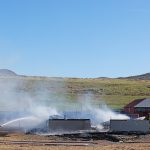Study highlights recreational trail impacts to wildlife habitat
Results can advise land managers, conservation groups

The community organization Keep Routt Wild and Denver-based nonprofit Rocky Mountain Wild released a joint study this week showing the impact of recreational trail use on wildlife habitat in Routt National Forest and how human recreation is leading to decreases in area elk habitat.
“We think human recreation is likely a significant factor in decreasing elk numbers and reproduction rates in game management unit 14, which stretches north to south between the Elk River and the Continental Divide,” said Larry Desjardin, president of Keep Routt Wild.
Desjardin said the study quantifies the elk habitat loss and compression in some 120,000 acres east of Steamboat Springs, where the impact to wildlife and fragmentation of elk habitat has been the most pronounced.
He said game management unit 14 has seen a 30% decline in the resident elk herd in the past 15 years.
Organizers say the local study was initiated after the Roaring Fork Valley and Eagle Valley elk herds experienced a 50% reduction in population from 1999 to 2015.
The purpose of the five-month study was twofold.
“One was to create a methodology whereby land managers and conservation groups could use the best available science and modern mapping tools to appraise the impacts of trail-based recreation onto wildlife habitat, both qualitatively and quantitatively,” Desjardin explained. “The second was to use these tools to analyze a specific area of Routt National Forest that has seen a significant increase in recreational development and use in recent years.”
The study shows a significant loss and fragmentation of elk habitat in areas including Buffalo Pass, Rabbit Ears Pass and three designated roadless areas of Mad Creek, Walton Peak and Long Park, which is north of U.S. 40 at Rabbit Ears Pass.
“This study gives insight into the recreational impacts that may be contributing to the decline and can serve as a valuable tool to avoid it in the future,” Desjardin said. “The area supports a great deal of recreation, hosting the Steamboat ski area, the Continental Divide Trail, an extensive trail network near Buffalo Pass and numerous other non-motorized and motorized trails.”
“Elk was chosen as the specific species of the study due to the worrisome decline of elk population and reproductive success in the area. Elk are migratory animals that need large, connected landscapes of healthy habitat to thrive. They are also an important contributor to Colorado’s outdoor economy through hunting and wildlife viewing,” he noted.
The analysis consisted of superimposing “disturbance bands” on roads and trails showing the distance from trails that elk would stay away to avoid different types of recreational users. This avoidance leads to elk abandoning habitat. The full study, including informational maps, can be found on the Keep Routt Wild website under the “Experts & Studies” tab and then “Wildlife Studies.”
The analysis shows elk may avoid 60% of the studied landscape, or more than 74,000 acres. A flight response from elk could take place in 88% of the landscape, or almost 110,000 acres.
“In only 12% of the entire landscape were elk considered undisturbed, a total of 14,000 acres out of 124,000,” according to the study.
The study superimposed elk-calving areas over the disturbance bands. The maps showed that a majority of these areas could be disturbed by human recreation. The study showed a handful of undisturbed habitat islands, each separated significantly by areas of human disturbance, which leads to habitat fragmentation and interferes with the natural movement and migration of elk, Desjardin said.
Steamboat Springs resident T.J. Thrasher, a study co-author and Keep Routt Wild board member, said although the study focused on elk, the disturbance bands can be a surrogate for many timid species that share the same habitat, such as dusky and ruffed grouse, mule deer, pronghorn, goshawks and numerous raptors.
“We are using elk as a proxy species for the observation and protection of a wide range of species and habitat,” Thrasher said.
District Ranger Michael Woodbridge with the Hahns Peak and Bears Ears Ranger District said the U.S. Forest Service has been working closely with Colorado Parks and Wildlife and the Department of Natural Resources on projects to help balance recreation opportunities with impacts to natural resources.
“Our coordination with CPW/DNR has helped reduce impacts to elk such as the use of seasonal area and trail closures during sensitive times of the year,” Woodbridge noted.

To reach Suzie Romig, call 970-871-4205 or email sromig@SteamboatPilot.com.

Support Local Journalism

Support Local Journalism
Readers around Steamboat and Routt County make the Steamboat Pilot & Today’s work possible. Your financial contribution supports our efforts to deliver quality, locally relevant journalism.
Now more than ever, your support is critical to help us keep our community informed about the evolving coronavirus pandemic and the impact it is having locally. Every contribution, however large or small, will make a difference.
Each donation will be used exclusively for the development and creation of increased news coverage.










